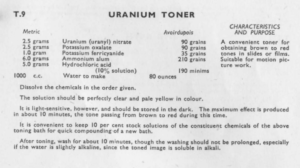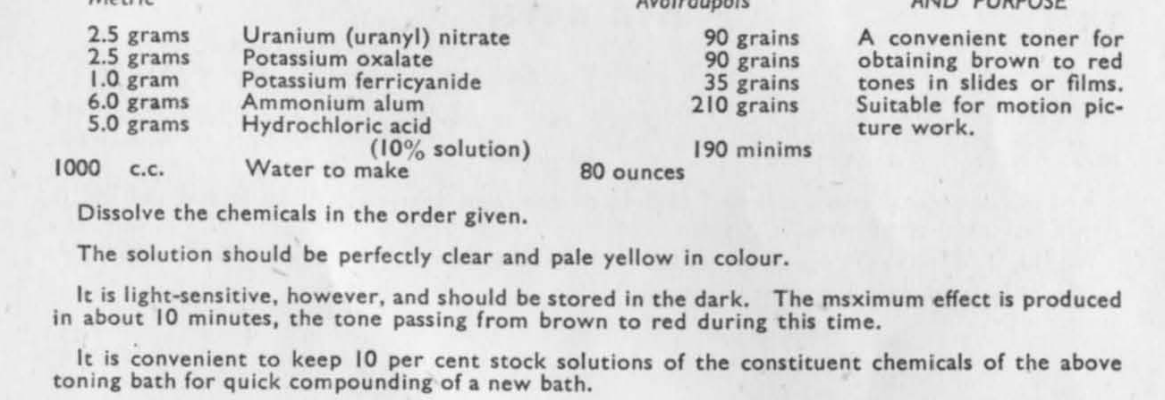Des années 1930 aux années 1950, Kodak Books a produit un toner à l’uranium (Kodak T-9) utilisant du nitrate d’uranium hexahydraté. Certains photographes utilisant des procédés alternatifs, dont Blake Ferris et Robert Schramm, continuent aujourd’hui de réaliser des tirages uranotypiques.
https://www.orau.org/health-physics-museum/collection/miscellaneous/curie-photo.html
The print shown in the photo to the right was treated for ten minutes in Kodak Uranium Toner K-9. It now contains about 3 milligrams of depleted uranium. The toning replaced some of the silver in the original print with uranium thus causing the image to change progressively from black to reddish brown. The surface activity in the darkest areas is approximately 160 cpm above background as measured with a 2″ pancake GM probe. How much uranium would end up in the final image would depend on how long the print was left in the toner and how dark the image was.
While not certain, it is possible that some of Ansel Adams’ original prints were treated with uranium toner—the latter was apparently found in his darkroom after his death. Unfortunately, I have not been able to locate any references to uranium toner in his books.
Adams often photographed landscapes in the same areas where uranium was mined. It would certainly have had a touch of poetry about it if any of his photographs incorporated uranium that came from the area where the photograph was taken.
There are various formulae for uranium toner. Here is one:
- Water: 1000 ml
- Uranium Nitrate: 2.5 g
- Potassium Oxalate: 2.5 g
- Potassium Ferricyanide: 1 g
- Ammonium Alum: 6 g
- Hydrochloric Acid (10%): 5 ml
Produced and donated by William Kolb.
https://www.orau.org/health-physics-museum/collection/miscellaneous/curie-photo.html
T.9 URANIUM TONER
Metric
2.5 grams Uranium (uranyl) nitrate 90 grains
2.5 grams Potassium oxalate 90 grains
1.0 grams Potassium ferricyanide 35 grains
6.0 grams Ammonium alum 210 grains
5.0 grams Hydrochloric acid (10% solution) 190 minims
1000 c.c. Water to make 80 ounces
Dissolve the chemicals In the order given. The solution should be perfectly clear and pale yellow In colour.
It is light sensitive, however and should be stored In the dark. The maximum effect is produced in about 10 minutes. The tone passing from brown to red during this time.
It is convenient to keep 10 percent stock solutions of the constituent chemicals of the above toning bath for quick compounding of a new bath. After toning, wash for about 10 minutes, though the washing should not be prolonged, especially if the water is slightly alkaline since the toned image is soluble in alkali.
CHARACTERISTICS AND PURPOSE. A convenient toner for obtaining brown to red tones in slides or films. Suitable for motion picture work.

https://real-photographs.co.uk/wp-content/uploads/2009/11/Kodak_formulary.pdf
